Microparticle Size and Quantities Effect on the Mechanical Features of End of Life Tires in Thermoplastic Composites
Abstract
:1. Introduction
2. Methodology
2.1. Thermoplastic Polymers
2.2. Composite Processing
2.3. Mechanical Test
3. Results and Mechanical Properties
3.1. Mechanical Properties of PVC/GTR Composites
3.2. Mechanical Properties of EVA/GTR Composites
3.3. Mechanical Properties of PP/GTR Composites
3.4. Mechanical Properties of HDPE/GTR Composites
3.5. Mechanical Properties of PA/GTR Composites
3.6. Mechanical Property of ABS/GTR Composites
3.7. Mechanical Property of PS/GTR Composites
3.8. Stress-Strain Curves
3.9. Thermal Analysis
3.10. Morphology Analysis
4. Composites Mechanical Behavior Comparison
Discussion
5. Conclusions
Author Contributions
Funding
Conflicts of Interest
References
- European Tyre Recycling Association (ETRA). Available online: www.etra-eu.org (accessed on 6 April 2020).
- Used Tyre Working Group (UTWG). Tyre Recycling; Department of Trade and Industry: London, UK, 2006; Available online: www.tyreindustryfederation.co.uk/wp-content/uploads//2015/02/Used_tyre.pdf (accessed on 4 December 2020).
- Liu, H.S.; Richard, C.P.; Mead, J.L.; Stacer, R.G. Development of Novel Applications for Using Recycled Rubber in Thermoplastics; Technical Research Program; Chelsea Center for Recycling and Economic Development, University of Massachusetts: Lowell, MA, USA, 2000. [Google Scholar]
- Figovslq, O.; Beilin, D.; Blank, N.; Potapo, J.; Chernyshe, V. Development of polymer concrete with polybutadiene matrix. Cem. Concr. Compos. 1996, 18, 437–444. [Google Scholar]
- Hernandez-Olivares, F.; Barluenga, G.; Bollatib, M.; Witoszekc, B. Static and dynamic behavior of recycled tyre rubber-filled concrete. Cem. Concr. Compos. 2002, 32, 1587–1596. [Google Scholar] [CrossRef]
- Goncharuk, G.P.; Knunyants, M.I.; Kryuchkov, A.N.; Obolonkova, E.S. Effect of the specific surface area and the shape of rubber crumb on the mechanical properties of rubber-filled plastics. J. Polym. Sci. Part. B Polym. Chem. 1998, 40, 166–169. [Google Scholar]
- Dierkes, W.K. Rubber recycling. In Recent Research Developments in Macromolecules; Pandalai, S.G., Ed.; Research Signpost: Trivandrum, India, 2003; Volume 7, pp. 265–292. [Google Scholar]
- Radeshkumar, C.; Karger-Kocsis, J. Thermoplastic dynamic vulcanisates containing LDPE, rubber, and thermochemically reclaimed ground tyre rubber. Plast. Rubber Compos. 2002, 31, 99–105. [Google Scholar] [CrossRef]
- Yehia, A.; Mull, M.A.; Ismail, M.N.; Hefny, Y.A.; Abdel-Bary, E.M. Effect of chemically modified waste rubber powder as a filler in natural rubber vulcanizates. J. Appl. Polym. Sci. 2004, 93, 30–36. [Google Scholar] [CrossRef]
- Colom, X.; Andreu-Mateu, F.; Cañavate, F.J.; Mujal, R.; Carrillo, F. Study of the influence of IPPD on thermo-oxidation process of elastomeric hose. J. Appl. Polym. Sci. 2009, 5, 2011–2018. [Google Scholar] [CrossRef]
- Cepeda-Jimenez, C.M.; Pastor-Blas, M.M.; Ferrándiz-Gómez, T.P.; Martín-Martinez, J.M. Surface Characterization of vulcanized Rubber treated with sulphuric acid and its adhesion to polyurethane adhesive. J. Adhes. 2000, 73, 135–160. [Google Scholar] [CrossRef]
- Mujal, R.; Marín-Genescà, M.; Orrit, J.; Rahhali, A.; Colom, X. Dielectric, mechanical, and thermal characterization of high-density polyethylene composites with ground tire rubber. J. Thermoplast. Compos. Mater. 2012, 25, 537–559. [Google Scholar] [CrossRef]
- Mujal, R.; Orrit, J.; Ramis, X.; Marin-Genesca, M.; Rahhali, A. Study on dielectric, mechanical and thermal properties of polypropylene (PP) composites with ground tyre rubber (GTR). Polym. Polym. Compos. 2012, 20. [Google Scholar] [CrossRef]
- Marin-Genesca, M.; Mujal, R. Compuesto etileno acetato de vinilo (EVA) reforzado con neumáticos fuera de uso (GTR) propiedades dieléctricas, mecánicas y térmicas. Afinidad 2014, 71, 101–111. [Google Scholar]
- Marin-Genesca, M.; Mujal, R.; Orrit, J. Características dieléctricas, térmicas y mecánicas de la poliamida (PA) reforzada con neumáticos fuera de uso. In Afinidad: Revista de Química Teórica y Aplicada; IQS: Barcelona, Spain, 2013; Volume 70, pp. 13–23. [Google Scholar]
- Marin-Genesca, M.; Mujal, R.; Ramis, X. Aplicaciones Dieléctricas del Poliestireno (PS) Cargado con Neumáticos Fuera de Uso (GTR); Revista DYNA: Bilbao, Spain, 2013; Volume 88, pp. 652–662. [Google Scholar]
- Mujal, R.; Orrit-Prat, J.; Ramis-Juan, X.; Marin-Genesca, M.; Rahhali, A. Dielectric, Thermal, and Mechanical Properties of Acrylonitrile Butadiene Styrene Reinforced with Used Tires. Adv. Polym. Technol. 2013, 32, E399–E415. [Google Scholar] [CrossRef]
- Mujal, R.; Ramis, X.; Orrit-Prat, J.; Marin, M. Study on dielectric, thermal, and mechanical properties of the ethylene vinyl acetate reinforced with ground tire rubber. J. Reinf. Plast. Compos. 2011, 30, 581–592. [Google Scholar] [CrossRef]
- Mujal, R.; Orrit-Prat, J.; Ramis-Juan, X.; Marin-Genesca, M. Electrical application of polyamide reinforced with old tire rubber (ground tire rubber): Dielectric, thermal, mechanical and structural properties. J. Thermoplast. Compos. Mater. 2014, 27, 1209–1231. [Google Scholar] [CrossRef]
- Nakason, C.; Kaesaman, A.; Supasanthitikul, P. The grafting of maleic anhydride onto natural rubber. Polym. Test. 2004, 23, 35–41. [Google Scholar] [CrossRef]
- La Mantia, F.P.; Lo Verso, S.; Tzankova Dintcheva, N. EVA Copolymer Based Nanocomposites. Macro Mater. Eng. 2002, 287, 909–914. [Google Scholar] [CrossRef]
- Marín-Genescà, M.; García-Amorós, J.; Mujal-Rosas, R.; Salueña Berna, X.; Massagués Vidal, L. Comparison of Mechanical and Electrical Characteristics of Various Polymers Blended with Ground Tire Rubber (GTR) and Applications. Appl. Sci. 2019, 9, 1564. [Google Scholar]
- Markov, A.; Fiedler, B.; Schulte, K. Electrical conductivity of carbon black/fibres filled glass-fibre-reinforced thermoplastic composites. Compos. Part. A Appl. Sci. Manuf. 2006, 37, 1390–1395. [Google Scholar] [CrossRef]
- Saad, A.L.G.; Aziz, H.A.; Dimitry, O.I.H. Studies of Electrical and Mechanical Properties of Polyvinyl chloride Mixed with Electrically Conductive Additives. J. Appl. Polym. Sci. 2004, 91, 1590–1598. [Google Scholar] [CrossRef]
- Ganesh, B.; Unnikrishnan, G.J. Cure characteristics, morphology, mechanical properties, and aging characteristics of silicone rubber/ethylene vinyl acetate blends. Appl. Polym. Sci. 2006, 99, 1069–1082. [Google Scholar] [CrossRef]
- Colom, X.; Cañavate, J.; Carrillo, F. Structural and mechanical studies on modified reused tyres composites. Eur. Polym. J. 2006, 42, 2369–2378. [Google Scholar] [CrossRef]
- Kim, J.I.; Ryu, S.H.; Chang, Y.W. Mechanical and Dynamic Mechanical Properties of Waste Rubber Powder/HDPE Composite. J. Appl. Polym. Sci. 2000, 77, 2595–2602. [Google Scholar] [CrossRef]
- Vesenjak, M.; Krstulović-Opara, L.; Ren, Z.; Domazet, Ž. Cell shape effect evaluation of polyamide cellular structures. Polym. Test. 2010, 29, 991. [Google Scholar] [CrossRef]
- Zhang, W.; Zhang, Y.; Zhang, G. Static, dynamic mechanical properties and microstructure characteristics of ultra-high performance cementitious composites. Sci. Eng. Compos. Mater. 2012, 19, 237–245. [Google Scholar] [CrossRef]
- Cheng, X.; Chen, H.; Huang, S.; Li, Z.; Guo, X. Improvement of the properties of plasma-modified ground tire rubber-filled cement paste. J. Appl. Polym. Sci. 2012, 126, 1837–1843. [Google Scholar] [CrossRef]
- Mujal-Rosas, R.; Marín-Genescà, M.; Ballart-Prunell, M. Dielectric properties of various polymers (PVC, EVA, HDPE, and PP) reinforced with ground tire rubber (GTR). Sci. Eng. Com. Mater. 2015, 22, 231–243. [Google Scholar] [CrossRef]
- Formela, K.; Haponiuk, J. Characterization and properties of LDPE/(ground tire rubber)/crosslinked butyl rubber blends. J. Vinyl Addit. Technol. 2014, 20, 237–242. [Google Scholar] [CrossRef]
- Nadal, A.; Boix, M.; Parres, F.; Agud, L.; Crespo, J.E.; Macías-García, A. Modelling the compression behavior of ground tire rubber. Materialwissenschaft Werkstofftechnik 2016, 47, 326–334. [Google Scholar] [CrossRef]
- Marín-Genescà, M.; García-Amorós, J.; Mujal-Rosas, R.; Vidal, L.M.; Arroyo, J.B.; Fajula, X.C. Ground Tire Rubber Recycling in Applications as Insulators in Polymeric Compounds, According to Spanish UNE Standards. Recycling 2020, 5, 16. [Google Scholar] [CrossRef]
- Marín-Genescà, M.; García-Amorós, J.; Mujal-Rosas, R.; Massagués, L.; Colom, X. Study and Characterization of the Dielectric Behavior of Low Linear Density Polyethylene Composites Mixed with Ground Tire Rubber Particles. Polymers 2020, 12, 1075. [Google Scholar] [CrossRef]
- Marín-Genescà, M.; García-Amorós, J.; Mujal-Rosas, R.; Massagués Vidal, L.; Colom Fajula, X. Application Properties Analysis as a Dielectric Capacitor of End-of-Life Tire-Reinforced HDPE. Polymers 2020, 12, 2675. [Google Scholar] [CrossRef]

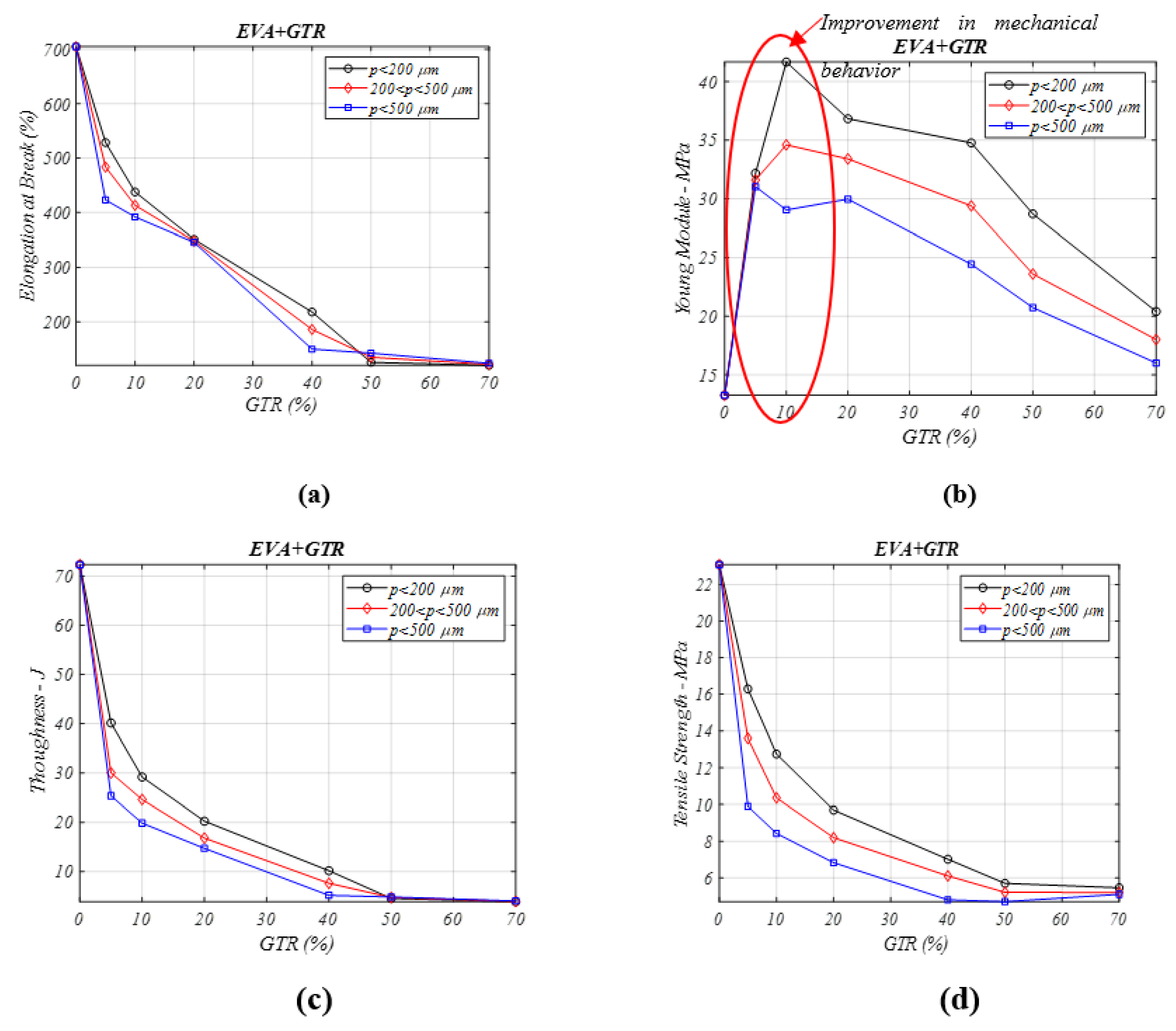
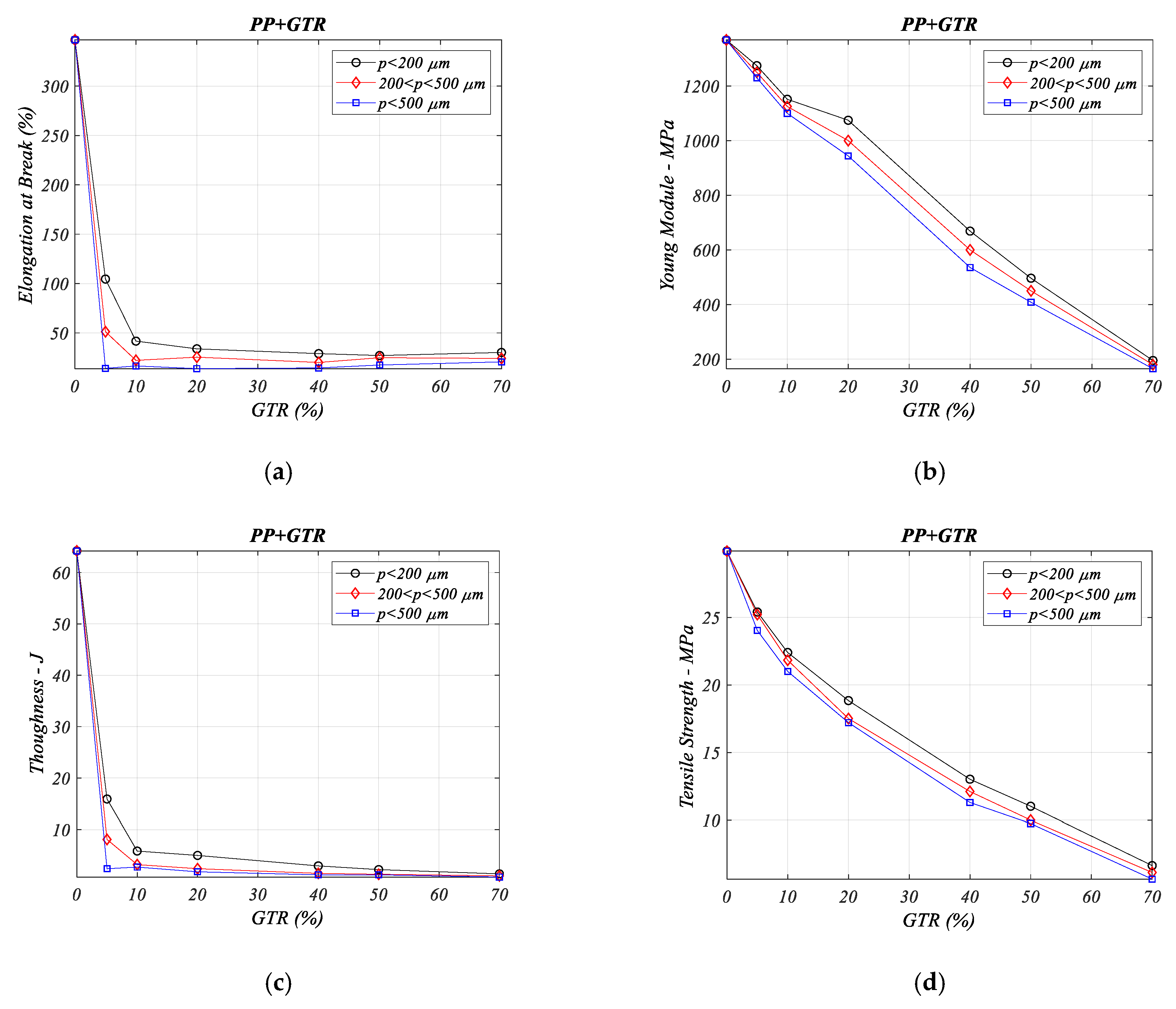

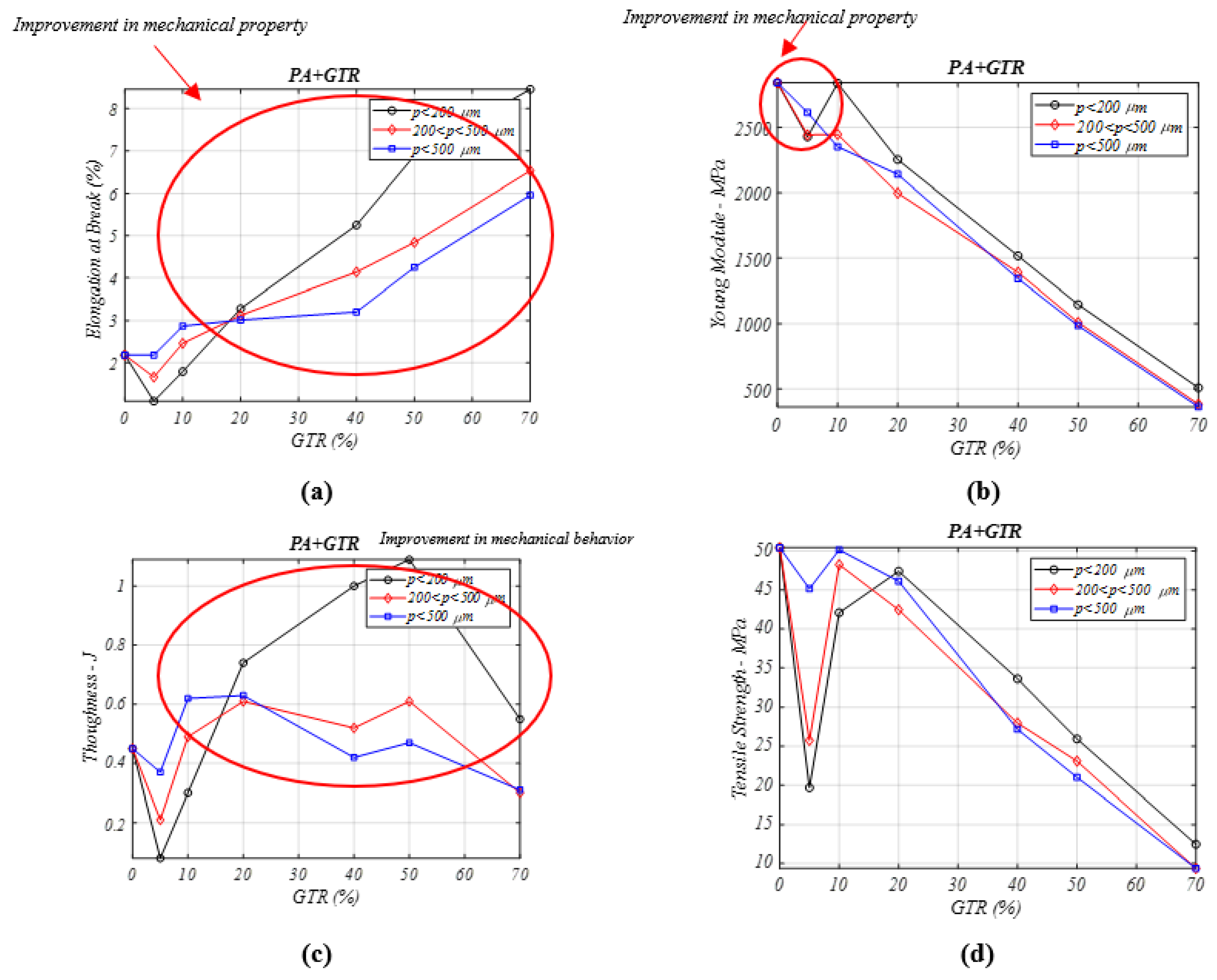


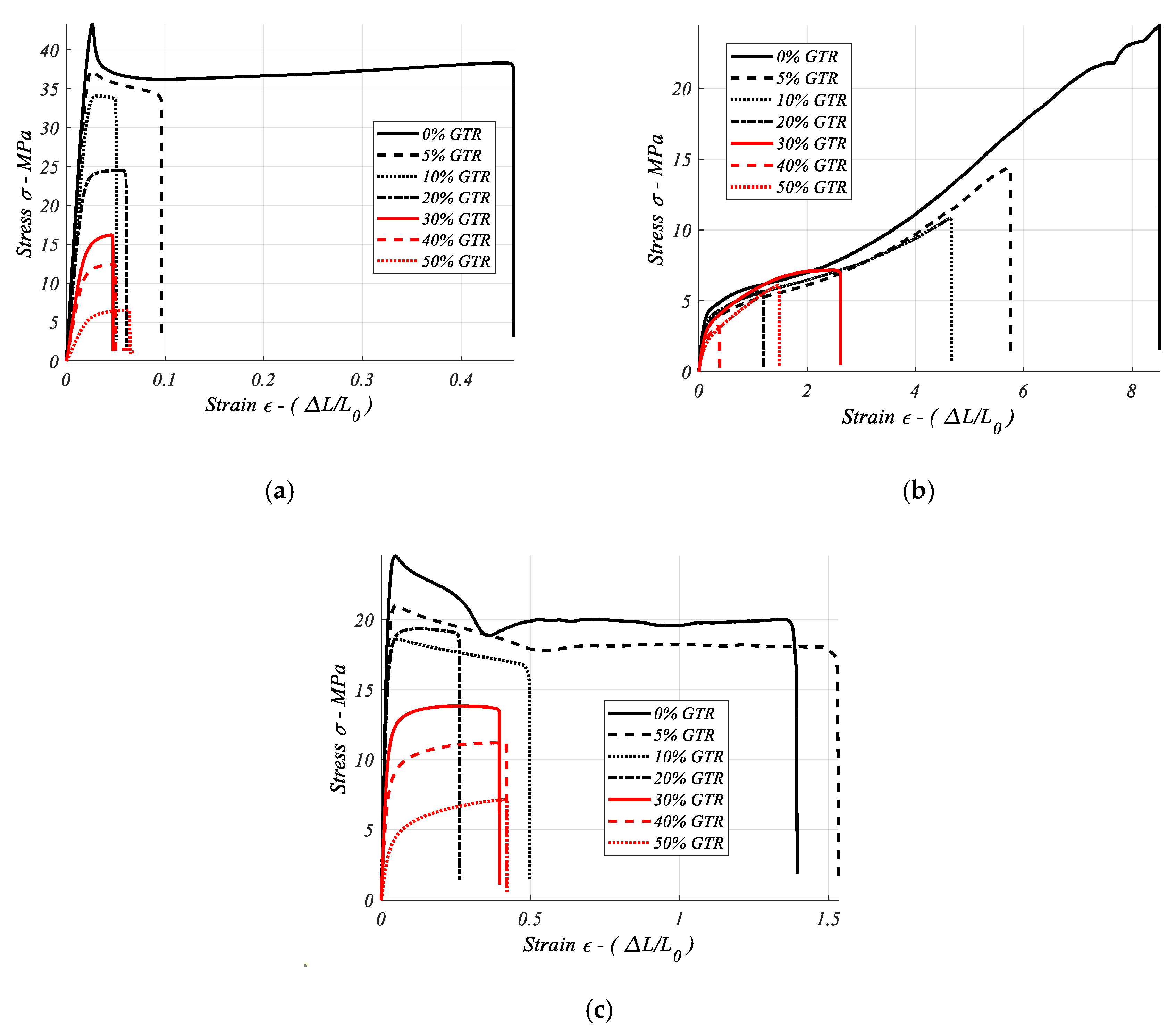
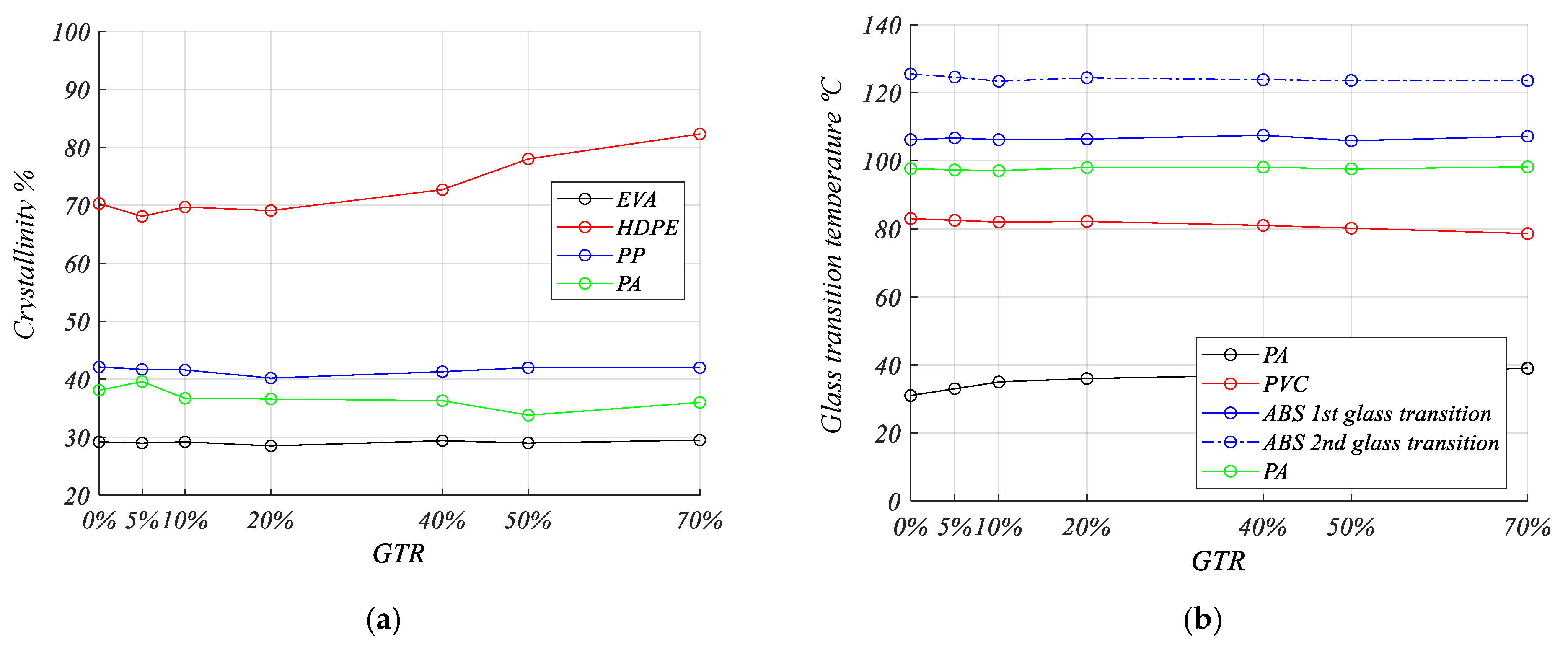
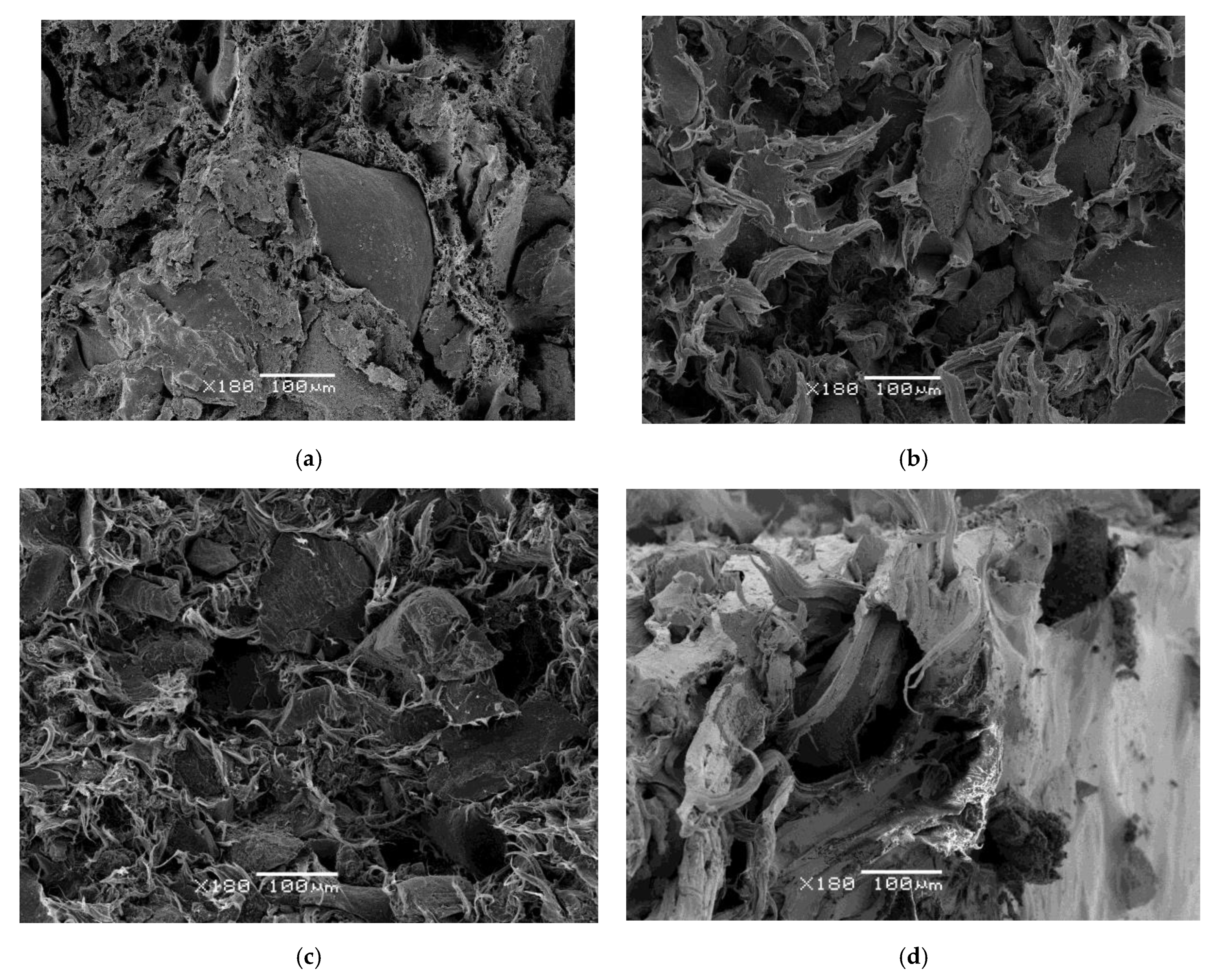

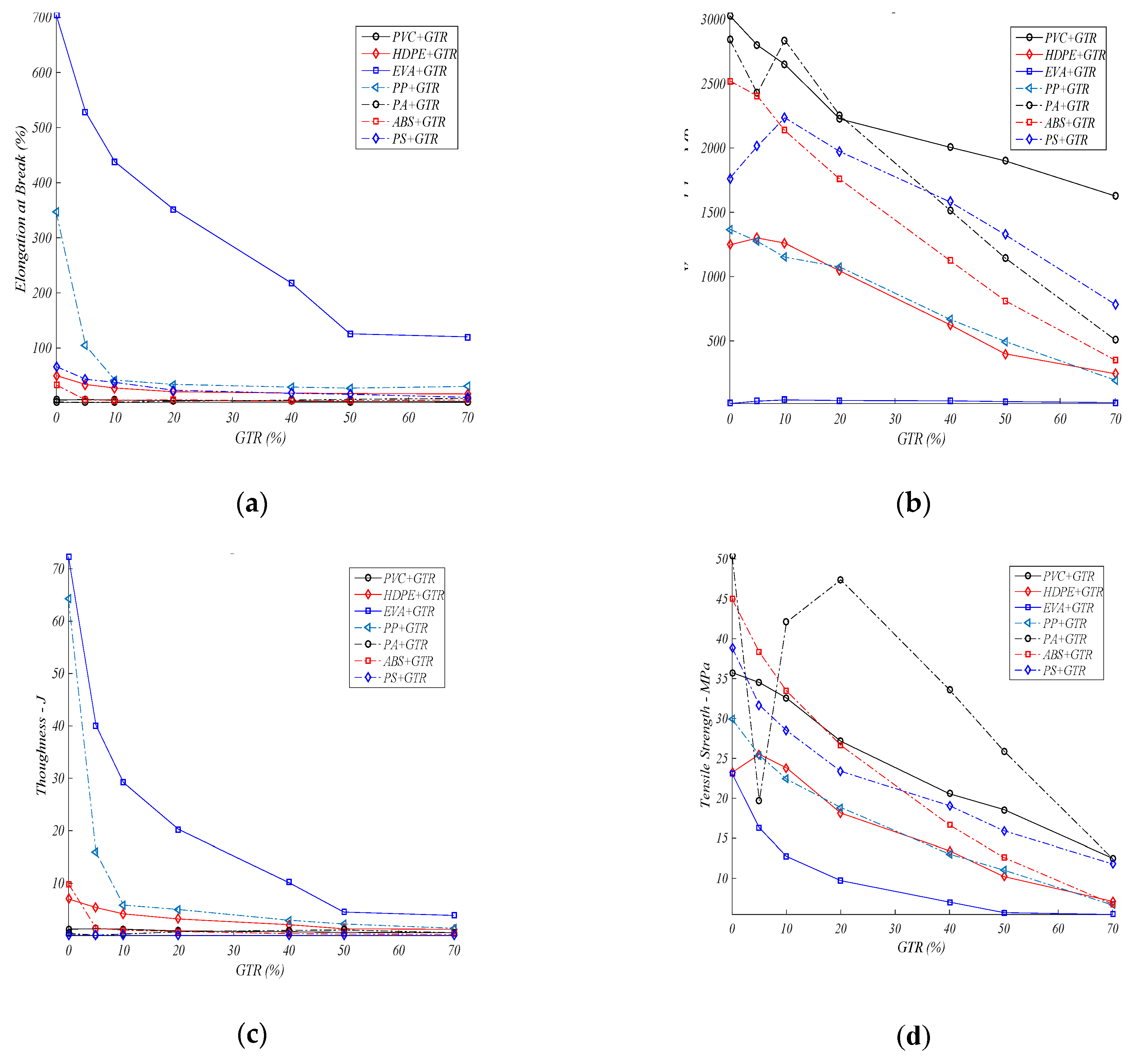
| Polymer Type | Commercial Name | Melt Flow Index (g/min) | Density (kg/m3) |
|---|---|---|---|
| PVC | Etinox | 1.35 | 1225 |
| EVA | Alcudia PA 539 type | 0.20 | 937 |
| HDPE | Alcudia 4810-B | 1.35 | 960 |
| PA 6 | Ultramid B3S | 1.55 | 1130 |
| ABS | Terluran® HH-106 | 1.45 | 1050 |
| PP | Isplen® 099 K2M type | 0.55 | 902 |
| PS | Polystyrol 486 M | 1.45 | 1050 |
| Polymer Type | Processing Temperature (°C) | Melting Temperature (°C) | Pressing Temperature (°C) |
|---|---|---|---|
| PVC | 195–200 °C | 200 °C | 210 °C |
| EVA | 105–110 °C | 110 °C | 120 °C |
| HDPE | 150–155 °C | 155 °C | 170 °C |
| PA 6 | 195–200 °C | 220 °C | 210 °C |
| ABS | 180–185 °C | 230 °C | 195 °C |
| PP | 155–165 °C | 165 °C | 165 °C |
| PS | 180–185 °C | 180°C | 195 °C |
| Composite | Improved Properties in GTR Polymeric Composites (p < 200 μm) | |
|---|---|---|
| PVC/GTR | Elongation at break: 6.31% (5% GTR) | Toughness: 1.31 J (5% GTR) |
| PA/GTR | Elongation at break: 8.46% (70% GTR) | Toughness: 1.09 J (50% GTR) |
| HDPE/GTR | Young’s modulus: 1300.11 MPa (5% GTR) | Tensile strength: 25.51 MPa(5% GTR) |
| PS/GTR | Young’s modulus: 2235.42 MPa (10% GTR) | |
| EVA/GTR | Young’s modulus: 41.67 MPa (10% GTR) | |
| Polymer Composite | Young’s Modulus (MPa) | Tensile Strength (MPa) | Elongation at Break (%) | Toughness (J) |
|---|---|---|---|---|
| PVC | 3028.89 | 35.75 | 5.4 | 1.25 |
| EVA | 13.26 | 23.08 | 704.6 | 72.32 |
| HDPE | 1246.34 | 23.23 | 50 | 7 |
| PP | 1368.65 | 29.9 | 346.71 | 64.22 |
| ABS | 2522.37 | 44.98 | 32.91 | 9.9 |
| PA | 2841.47 | 50.41 | 2.18 | 0.45 |
| PS | 1764.48 | 38.89 | 66.27 | 0.20 |
Publisher’s Note: MDPI stays neutral with regard to jurisdictional claims in published maps and institutional affiliations. |
© 2020 by the authors. Licensee MDPI, Basel, Switzerland. This article is an open access article distributed under the terms and conditions of the Creative Commons Attribution (CC BY) license (http://creativecommons.org/licenses/by/4.0/).
Share and Cite
Marín-Genescà, M.; García-Amorós, J.; Mujal-Rosas, R.; Massagués Vidal, L.; Colom Fajula, X. Microparticle Size and Quantities Effect on the Mechanical Features of End of Life Tires in Thermoplastic Composites. Materials 2020, 13, 5561. https://doi.org/10.3390/ma13235561
Marín-Genescà M, García-Amorós J, Mujal-Rosas R, Massagués Vidal L, Colom Fajula X. Microparticle Size and Quantities Effect on the Mechanical Features of End of Life Tires in Thermoplastic Composites. Materials. 2020; 13(23):5561. https://doi.org/10.3390/ma13235561
Chicago/Turabian StyleMarín-Genescà, Marc, Jordi García-Amorós, Ramon Mujal-Rosas, Lluís Massagués Vidal, and Xavier Colom Fajula. 2020. "Microparticle Size and Quantities Effect on the Mechanical Features of End of Life Tires in Thermoplastic Composites" Materials 13, no. 23: 5561. https://doi.org/10.3390/ma13235561
APA StyleMarín-Genescà, M., García-Amorós, J., Mujal-Rosas, R., Massagués Vidal, L., & Colom Fajula, X. (2020). Microparticle Size and Quantities Effect on the Mechanical Features of End of Life Tires in Thermoplastic Composites. Materials, 13(23), 5561. https://doi.org/10.3390/ma13235561








